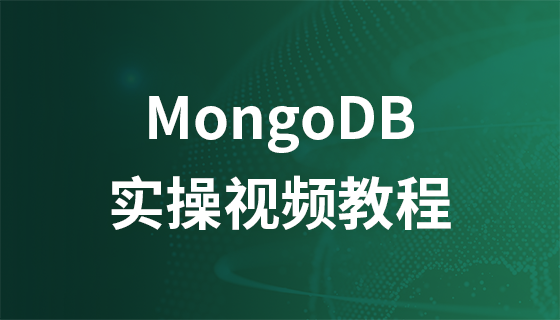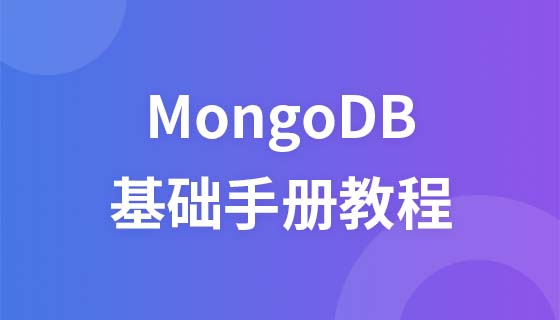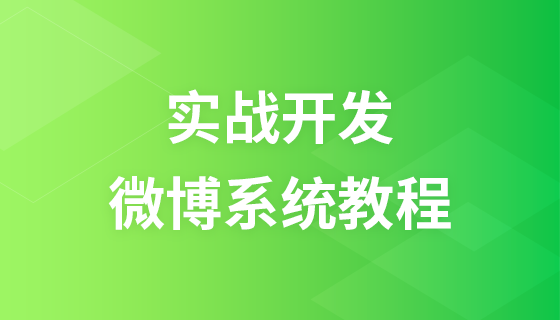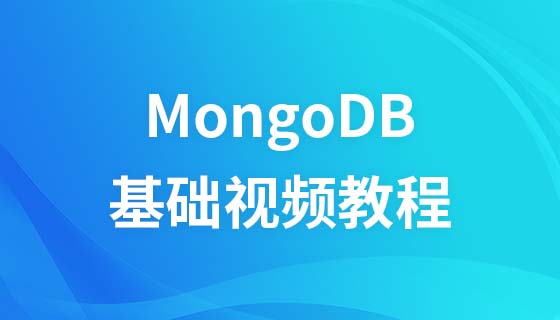這篇文章帶給大家的內容是關於MongoDB的常用Query操作的介紹(附程式碼),有一定的參考價值,有需要的朋友可以參考一下,希望對你有幫助。
前言:使用的視覺化工具是Studio 3T,官網-->https://studio3t.com/
版本號:MongoDB shell version v3.4.2
如何使用:https:/ /blog.csdn.net/weixin_...
看點:重點看操作符那塊。
如何尋找:在此頁面按ctrl F 輸入關鍵字尋找
一、常用Query
為方便操作,在插入原始資料前,先刪除所有文件( 在專案中請謹慎操作!):
db.getCollection("inventory").deleteMany({})0、查看所有文件
db.getCollection("inventory").find({})1、物件查找
1.1、原始資料
db.inventory.insertMany( [
{ item: "journal", qty: 25, size: { h: 14, w: 21, uom: "cm" }, status: "A" },
{ item: "notebook", qty: 50, size: { h: 8.5, w: 11, uom: "in" }, status: "A" },
{ item: "paper", qty: 100, size: { h: 8.5, w: 11, uom: "in" }, status: "D" },
{ item: "planner", qty: 75, size: { h: 22.85, w: 30, uom: "cm" }, status: "D" },
{ item: "postcard", qty: 45, size: { h: 10, w: 15.25, uom: "cm" }, status: "A" }
]);1.2、查找size.h 等於14,size.w 等於21,size.uom 等於cm 的文檔
db.inventory.find( { size: { h: 14, w: 21, uom: "cm" } } )1.3、查找size.uom 等於in 的文檔
db.inventory.find( { "size.uom": "in" } )注意:當尋找單一物件屬性時,請務必加上引號!
1.4、尋找並傳回物件裡的指定欄位
db.inventory.find(
{ status: "A" },
{ item: 1, status: 1, "size.uom": 1 }
)1.5、尋找並篩選物件裡的指定欄位
db.inventory.find(
{ status: "A" },
{ "size.uom": 0 }
)2、陣列查找
2.1、原始資料
db.inventory.insertMany([
{ item: "journal", qty: 25, tags: ["blank", "red"], dim_cm: [ 14, 21 ] },
{ item: "notebook", qty: 50, tags: ["red", "blank"], dim_cm: [ 14, 21 ] },
{ item: "paper", qty: 100, tags: ["red", "blank", "plain"], dim_cm: [ 14, 21 ] },
{ item: "planner", qty: 75, tags: ["blank", "red"], dim_cm: [ 22.85, 30 ] },
{ item: "postcard", qty: 45, tags: ["blue"], dim_cm: [ 10, 15.25 ] }
]);2.2、尋找tags=["red", "blank"] 的文件
db.inventory.find( { tags: ["red", "blank"] } )注意:不是包含關係,即tags: ["red", "blank", "plain"] 是不包括在內的
2.3、查找tags 包含red 的文檔
db.inventory.find( { tags: "red" } )#注意:不能這麼寫db.inventory.find( { tags: ["red"] } ),這樣就表示查找tags 是red 的文檔
3、數組中包含物件的查找
3.1、原始資料
db.inventory.insertMany( [
{ item: "journal", instock: [ { warehouse: "A", qty: 5 }, { warehouse: "C", qty: 15 } ] },
{ item: "notebook", instock: [ { warehouse: "C", qty: 5 } ] },
{ item: "paper", instock: [ { warehouse: "A", qty: 60 }, { warehouse: "B", qty: 15 } ] },
{ item: "planner", instock: [ { warehouse: "A", qty: 40 }, { warehouse: "B", qty: 5 } ] },
{ item: "postcard", instock: [ { warehouse: "B", qty: 15 }, { warehouse: "C", qty: 35 } ] }
]);3.2、尋找陣列中有一個物件符合條件的(不是包含),只要陣列中有一個物件符合條件就回傳整個陣列
db.inventory.find( { "instock": { warehouse: "A", qty: 5 } } )要嚴格按照字段的順序來,如果調換字段順序會找不到,如下:
db.inventory.find( { "instock": { qty: 5, warehouse: "A" } } )3.3、查找數組中的元素對象,有一個元素物件的qty=5,或該物件(或其他元素物件)的warehouse=A
db.inventory.find( { "instock.qty": 5, "instock.warehouse": "A" } )3.4、找出陣列中的對象,並傳回物件的某個屬性
db.inventory.find( { status: "A" }, { item: 1, status: 1, "instock.qty": 1 } )4、普通查找
4.1、原始資料
db.inventory.insertMany( [
{ item: "journal", status: "A", size: { h: 14, w: 21, uom: "cm" }, instock: [ { warehouse: "A", qty: 5 } ] },
{ item: "notebook", status: "A", size: { h: 8.5, w: 11, uom: "in" }, instock: [ { warehouse: "C", qty: 5 } ] },
{ item: "paper", status: "D", size: { h: 8.5, w: 11, uom: "in" }, instock: [ { warehouse: "A", qty: 60 } ] },
{ item: "planner", status: "D", size: { h: 22.85, w: 30, uom: "cm" }, instock: [ { warehouse: "A", qty: 40 } ] },
{ item: "postcard", status: "A", size: { h: 10, w: 15.25, uom: "cm" }, instock: [ { warehouse: "B", qty: 15 }, { warehouse: "C", qty: 35 } ] }
]);4.2、查詢並傳回指定欄位
在status=A 的條件下,傳回_id,item,status 欄位
db.inventory.find( { status: "A" }, { item: 1, status: 1 } )結果:
{ "_id" : ObjectId("5c91cd53e98d5972748780e1"),
"item" : "journal",
"status" : "A"}
// ----------------------------------------------
{ "_id" : ObjectId("5c91cd53e98d5972748780e2"),
"item" : "notebook",
"status" : "A"}
// ----------------------------------------------
{ "_id" : ObjectId("5c91cd53e98d5972748780e5"),
"item" : "postcard",
"status" : "A"}4.3、由4.2 可知,_id 是自動帶著的,可以去掉,如下
查詢不帶(去掉) id :
db.inventory.find( { status: "A" }, { item: 1, status: 1, _id: 0 } )注意:除了id 可以在過濾掉的同時,還去保留其他字段外,其他字段不能在0 的同時,還寫1
如:
db.inventory.find( { status: "A" }, { item: 1, status: 0 } )會報錯
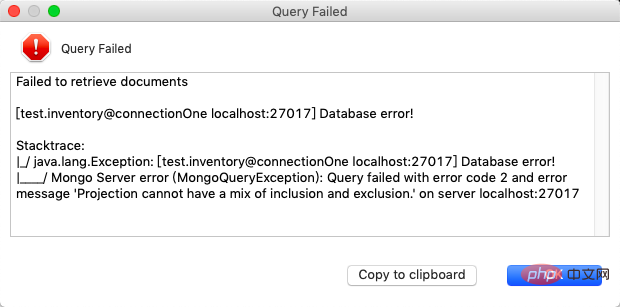
4.4、排除特定字段,返回其他字段
db.inventory.find( { status: "A" }, { status: 0, instock: 0 } )5、查找null 或不存在的鍵
5.1、原始資料
db.inventory.insertMany([
{ _id: 1, item: null },
{ _id: 2 }
])5.2、查找item 為null 的文檔,或不包含item 的文檔
db.inventory.find( { item: null } )#二、運算符
1、$lt less than 小於
1.1、原始資料
db.inventory.insertMany( [
{ item: "journal", qty: 25, size: { h: 14, w: 21, uom: "cm" }, status: "A" },
{ item: "notebook", qty: 50, size: { h: 8.5, w: 11, uom: "in" }, status: "A" },
{ item: "paper", qty: 100, size: { h: 8.5, w: 11, uom: "in" }, status: "D" },
{ item: "planner", qty: 75, size: { h: 22.85, w: 30, uom: "cm" }, status: "D" },
{ item: "postcard", qty: 45, size: { h: 10, w: 15.25, uom: "cm" }, status: "A" }
]);1.2、尋找"size.h" 小於15 的文件集合
db.inventory.find( { "size.h": { $lt: 15 } } )1.3、$lt 與AND 聯用
查找size.h 小於15,且size.uom 是in ,且status 是D 的文檔
db.inventory.find( { "size.h": { $lt: 15 }, "size.uom": "in", status: "D" } )#2、$lte less than equal 小於等於
2.1、原始資料
db.inventory.insertMany( [
{ item: "journal", instock: [ { warehouse: "A", qty: 5 }, { warehouse: "C", qty: 15 } ] },
{ item: "notebook", instock: [ { warehouse: "C", qty: 5 } ] },
{ item: "paper", instock: [ { warehouse: "A", qty: 60 }, { warehouse: "B", qty: 15 } ] },
{ item: "planner", instock: [ { warehouse: "A", qty: 40 }, { warehouse: "B", qty: 5 } ] },
{ item: "postcard", instock: [ { warehouse: "B", qty: 15 }, { warehouse: "C", qty: 35 } ] }
]);2.2、查找instock.qty 小於等於20 的文檔,只要數組中有一個物件符合條件就返回整個數組
db.inventory.find( { 'instock.qty': { $lte: 20 } } )3、$gt greater than 大於
3.1、原始資料
db.inventory.insertMany([
{ item: "journal", qty: 25, tags: ["blank", "red"], dim_cm: [ 14, 21 ] },
{ item: "notebook", qty: 50, tags: ["red", "blank"], dim_cm: [ 14, 21 ] },
{ item: "paper", qty: 100, tags: ["red", "blank", "plain"], dim_cm: [ 14, 21 ] },
{ item: "planner", qty: 75, tags: ["blank", "red"], dim_cm: [ 22.85, 30 ] },
{ item: "postcard", qty: 45, tags: ["blue"], dim_cm: [ 10, 15.25 ] }
]);3.2、查找dim_cm 大於25 的文件
db.inventory.find( { dim_cm: { $gt: 25 } } )注意:只要包含大於25 的元素的數組,都是符合條件的
3.3、查找dim_cm 大於15,或小於20,或既大於15,又小於20 的文檔
db.inventory.find( { dim_cm: { $gt: 15, $lt: 20 } } )3.4 、查找dim_cm 既大於22,又小於30 的文檔(是判斷數組的某一個元素是否是大於22,且小於30的,而不是判斷數組的所有元素)
db.inventory.find( { dim_cm: { $elemMatch: { $gt: 22, $lt: 30 } } } )3.5、根據數組位置尋找
尋找dim_cm 的第二個元素大於25 的文件
db.inventory.find( { "dim_cm.1": { $gt: 25 } } )4、$size 依照陣列長度找出##找出tags
長度是3 的文件
db.inventory.find( { "tags": { $size: 3 } } )5、$gte 大於等於5.1、原始資料
db.inventory.insertMany( [
{ item: "journal", instock: [ { warehouse: "A", qty: 5 }, { warehouse: "C", qty: 15 } ] },
{ item: "notebook", instock: [ { warehouse: "C", qty: 5 } ] },
{ item: "paper", instock: [ { warehouse: "A", qty: 60 }, { warehouse: "B", qty: 15 } ] },
{ item: "planner", instock: [ { warehouse: "A", qty: 40 }, { warehouse: "B", qty: 5 } ] },
{ item: "postcard", instock: [ { warehouse: "B", qty: 15 }, { warehouse: "C", qty: 35 } ] }
]);db.inventory.find( { 'instock.0.qty': { $gte: 20 } } )6、$elemMatch 物件的屬性符合6.1、在陣列中尋找符合qty=5, warehouse="A " 的對象,並傳回該文件集合
db.inventory.find( { "instock": { $elemMatch: { qty: 5, warehouse: "A" } } } )且小於等於20 的文件集合
db.inventory.find( { "instock": { $elemMatch: { qty: { $gt: 10, $lte: 20 } } } } )如果不使用 $elemMatch 的话,就表示 qty 大于 10 或者小于等于 20,官方文档意思是,不在数组的某一个元素找 既满足条件 A 又满足条件 B 的 qty,而是在数组的所有元素上找,满足条件 A 或满足条件 B 的 qty
db.inventory.find( { "instock.qty": { $gt: 10, $lte: 20 } } )7、$slice 返回数组特定位置的元素
7.1、原数据
db.inventory.insertMany([
{ item: "journal", qty: 25, tags: ["blank", "red"], dim_cm: [ 14, 21 ] },
{ item: "notebook", qty: 50, tags: ["red", "blank"], dim_cm: [ 14, 21 ] },
{ item: "paper", qty: 100, tags: ["red", "blank", "plain"], dim_cm: [ 14, 21 ] },
{ item: "planner", qty: 75, tags: ["blank", "red"], dim_cm: [ 22.85, 30 ] },
{ item: "postcard", qty: 45, tags: ["blue"], dim_cm: [ 10, 15.25 ] }
]);7.2、查找并返回 tags 数组的最后一个元素
db.inventory.find( { item: "journal" }, { item: 1, qty: 0, tags: { $slice: -1 } } )结果:
{
"_id" : ObjectId("5c91dce5e98d5972748780e6"),
"item" : "journal",
"tags" : [
"red"
]
}8、$type 返回指定类型的元素
8.1、原数据
db.inventory.insertMany([
{ _id: 1, item: null },
{ _id: 2 }
])8.2、返回 null 类型的数据
db.inventory.find( { item : { $type: 10 } } )类型如下:
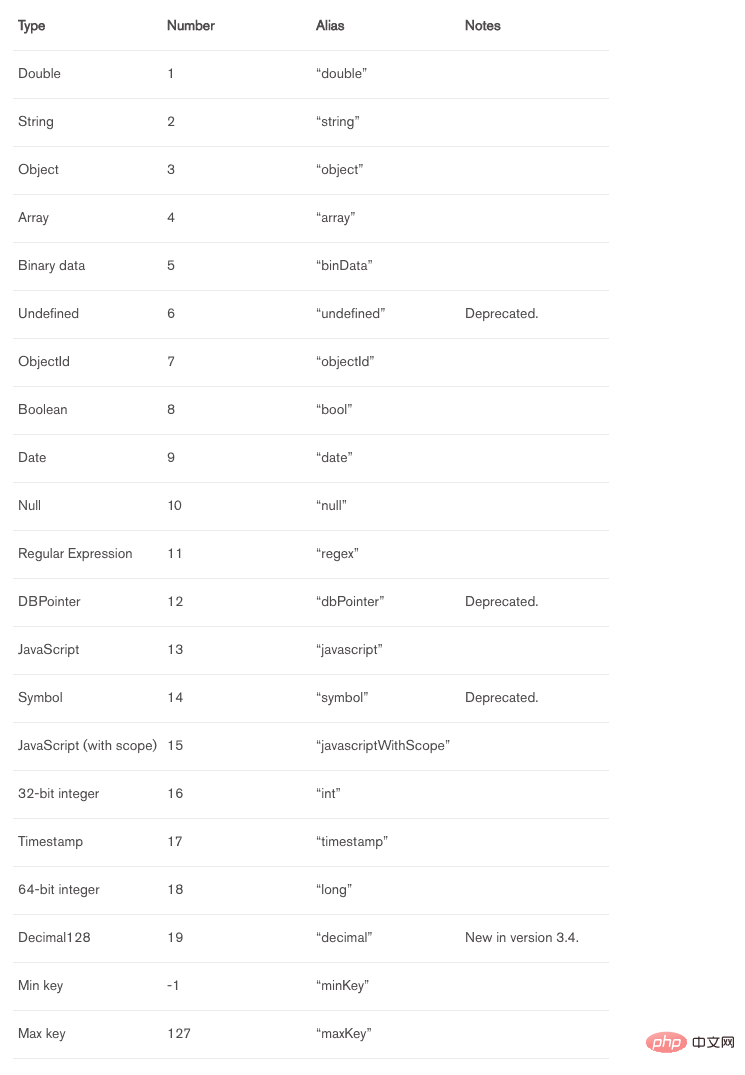
详细文档请看:https://docs.mongodb.com/manu...
9、$exists 返回存在/不存在的键
查找不存在 item 键的数据
db.inventory.find( { item : { $exists: false } } )10、$all 包含
10.1、原数据
db.inventory.insertMany([
{ item: "journal", qty: 25, tags: ["blank", "red"], dim_cm: [ 14, 21 ] },
{ item: "notebook", qty: 50, tags: ["red", "blank"], dim_cm: [ 14, 21 ] },
{ item: "paper", qty: 100, tags: ["red", "blank", "plain"], dim_cm: [ 14, 21 ] },
{ item: "planner", qty: 75, tags: ["blank", "red"], dim_cm: [ 22.85, 30 ] },
{ item: "postcard", qty: 45, tags: ["blue"], dim_cm: [ 10, 15.25 ] }
]);10.2、查找 tags 数组包含 ["red", "blank"] 的文档
db.inventory.find( { tags: { $all: ["red", "blank"] } } )综上:
数组用的:$all、$size、$slice
对象用的:$elemMatch
Query查询的详细文档请看:https://docs.mongodb.com/manu...
Operator的详细文档请看:https://docs.mongodb.com/manu...
本篇文章到这里就已经全部结束了,更多其他精彩内容可以关注PHP中文网的mongodb视频教程栏目!
以上是MongoDB的常用Query操作的介紹(附程式碼)的詳細內容。更多資訊請關注PHP中文網其他相關文章!
